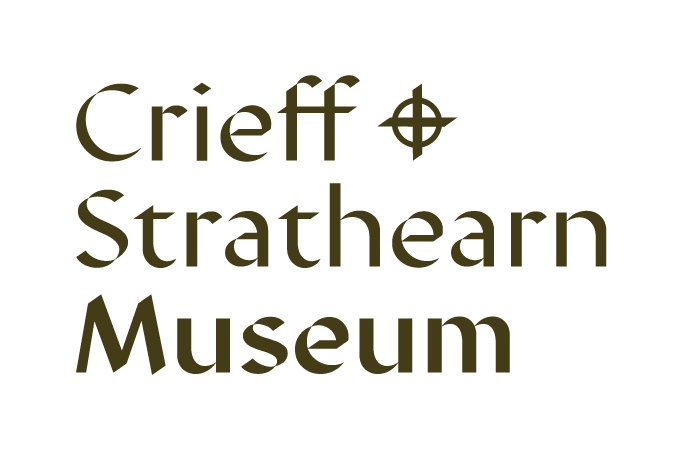Strathearn's Railways during World War II
by David Ferguson
If war should come again, ‘Oh my.
What can we dae!’ will be their cry,
‘We’ve nae lines noo tae move the guns
As we had when we focht the Huns!’
A headache, we must all agree
But only for ‘The Powers that be’.
What can we dae!’ will be their cry,
‘We’ve nae lines noo tae move the guns
As we had when we focht the Huns!’
A headache, we must all agree
But only for ‘The Powers that be’.
This is a verse from a poem titled ‘Crieff Railway’ about the demise of the railway in Crieff written by local Signalman Willie Elder, and it makes a reference to the role the railways of Strathearn played during World War 2. Although road vehicles and the roads themselves were getting better, railways were still the best way for moving large quantities or bulky items, especially during times of conflict.
It seems the Crieff Lines played a wide and varied role as the war developed.
Some pre-planning had been done, so when war was declared on 3rd September 1939, evacuees had already arrived in Strathearn by train, from Glasgow. ‘Operation Pied Piper’ saw the evacuation of millions of school-children, teachers, mothers and infants from areas across the country that were deemed to be at risk of bombing, to other less vulnerable areas, and Strathearn played its part.
The Strathearn Herald of 2nd September states, ‘Two trainloads of children, numbering close on 1,500, accompanied by teachers, arrived in Crieff. These were children from ‘Springbank’ and ‘Finnieston’ Schools in Glasgow. The following afternoon saw the final allocation for Crieff, ‘arriving in 3 trains – making for a busy station with over 1,000 evacuees on the platform!’ Comrie, also had an allocation and more were billeted at Lochearnhead and throughout the parish of Balquhidder. 150 children were accommodated in
St.Fillans, while other parts, such as Almondbank had a large contingent, also from the Glasgow area.
It seems the Crieff Lines played a wide and varied role as the war developed.
Some pre-planning had been done, so when war was declared on 3rd September 1939, evacuees had already arrived in Strathearn by train, from Glasgow. ‘Operation Pied Piper’ saw the evacuation of millions of school-children, teachers, mothers and infants from areas across the country that were deemed to be at risk of bombing, to other less vulnerable areas, and Strathearn played its part.
The Strathearn Herald of 2nd September states, ‘Two trainloads of children, numbering close on 1,500, accompanied by teachers, arrived in Crieff. These were children from ‘Springbank’ and ‘Finnieston’ Schools in Glasgow. The following afternoon saw the final allocation for Crieff, ‘arriving in 3 trains – making for a busy station with over 1,000 evacuees on the platform!’ Comrie, also had an allocation and more were billeted at Lochearnhead and throughout the parish of Balquhidder. 150 children were accommodated in
St.Fillans, while other parts, such as Almondbank had a large contingent, also from the Glasgow area.
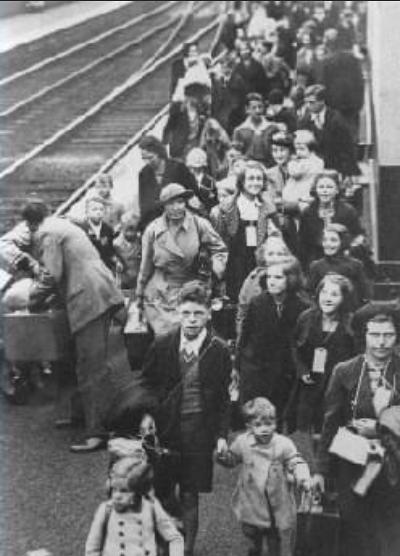
1 Evacuees at Dunning 1939
Dunning Parish Historical Association
Seymour Lodge School moved from Dundee to Ochtertyre and was still there after the war ended.
Apart from the arrival of evacuees, life in Strathearn at the start of the war seems to have continued much as before with both the railways and Alexander’s buses advertising weekly excursions to various parts of the country. Trade during the year at the bleachworks at Almondbank was good and steady, and so the railway was kept busy with raw materials in, plus many wagons of coal, and finished products out. This would have been the same from Perth to Balquhidder and Crieff to Gleneagles, where the railway brought in supplies and carried away finished goods, with coal for heating homes and schools, and powering various works being one of the main items brought into Strathearn.
However, some signs of war were also beginning to show as the Strathearn Herald of 23rd September 1939 reported that ‘local train services have been greatly curtailed (see 1939 timetable which shows previously there had been 6 via Perth, and 10 via Gleneagles) with Perth-Crieff now only having 3 trains per day each way, and to the south there are 4, although generally bus services to the cities are good.’ West of St.Fillans suffered worse, in that the service was now reduced to 2 trains per day in each direction, compared to the 6 in the 1939 timetable. This was presumably to reduce traffic into Balquhidder on the Callander & Oban line, as this line would have been busy with traffic to and from the west coast ports.
Apart from the arrival of evacuees, life in Strathearn at the start of the war seems to have continued much as before with both the railways and Alexander’s buses advertising weekly excursions to various parts of the country. Trade during the year at the bleachworks at Almondbank was good and steady, and so the railway was kept busy with raw materials in, plus many wagons of coal, and finished products out. This would have been the same from Perth to Balquhidder and Crieff to Gleneagles, where the railway brought in supplies and carried away finished goods, with coal for heating homes and schools, and powering various works being one of the main items brought into Strathearn.
However, some signs of war were also beginning to show as the Strathearn Herald of 23rd September 1939 reported that ‘local train services have been greatly curtailed (see 1939 timetable which shows previously there had been 6 via Perth, and 10 via Gleneagles) with Perth-Crieff now only having 3 trains per day each way, and to the south there are 4, although generally bus services to the cities are good.’ West of St.Fillans suffered worse, in that the service was now reduced to 2 trains per day in each direction, compared to the 6 in the 1939 timetable. This was presumably to reduce traffic into Balquhidder on the Callander & Oban line, as this line would have been busy with traffic to and from the west coast ports.
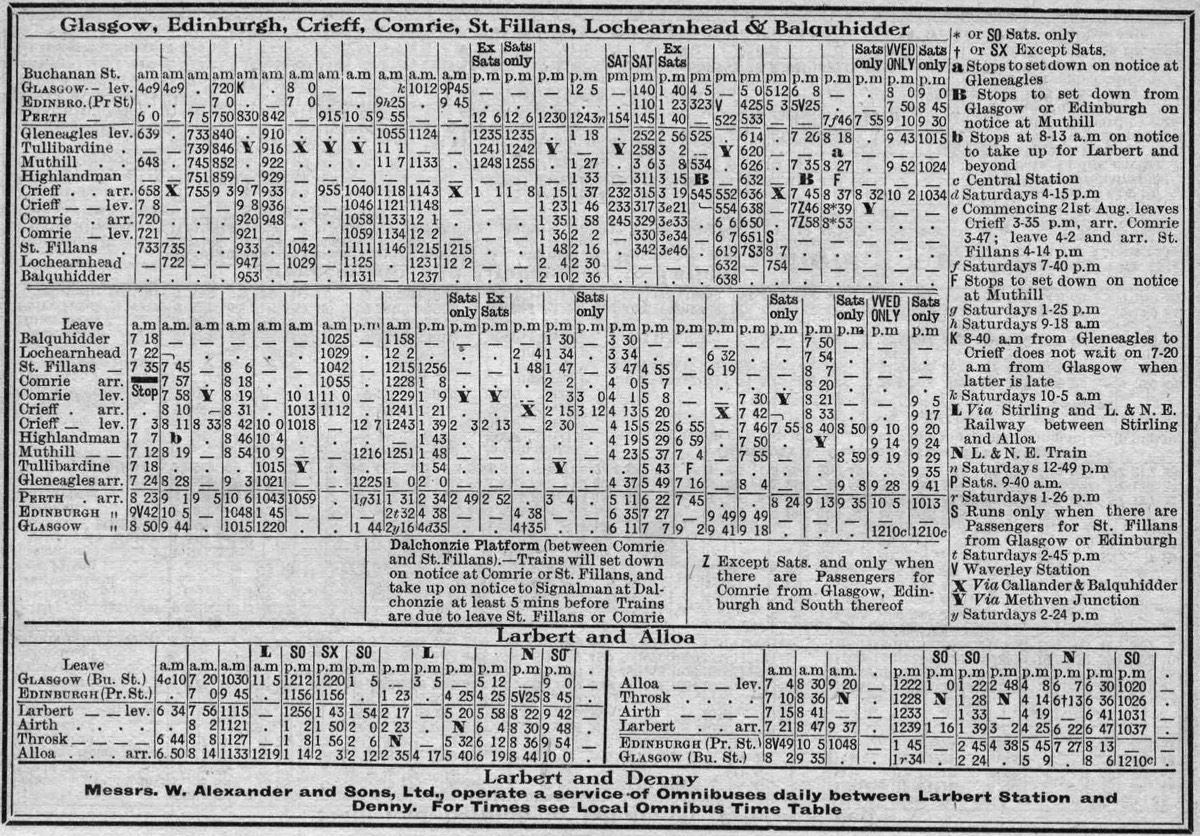
David Ferguson Collection
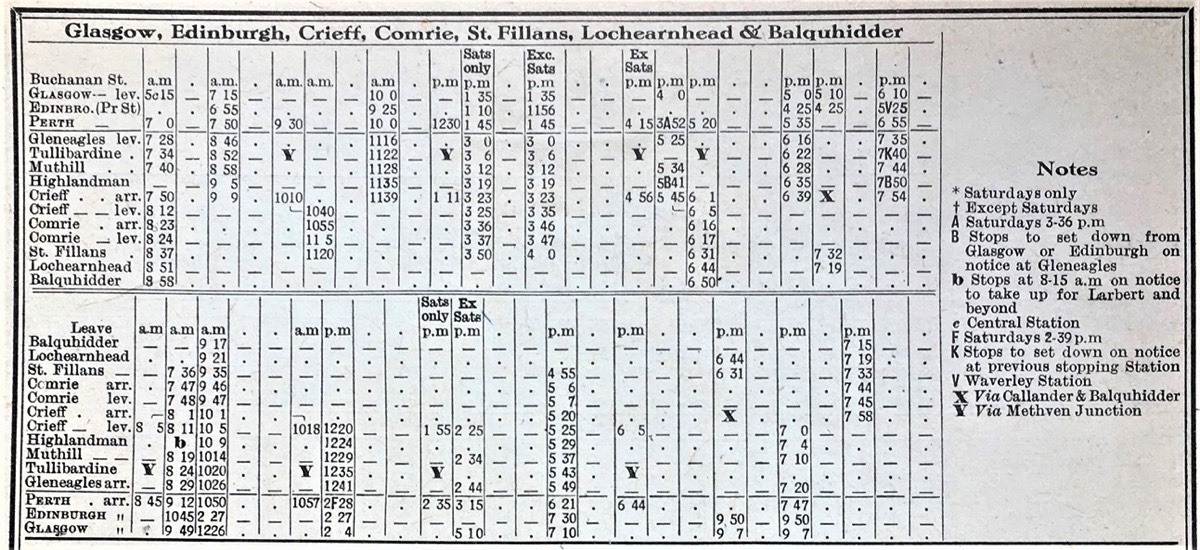
3 LMS reduced Timetable
Glasgow-Edinburgh-Crieff-Balquhidder
David Ferguson Collection
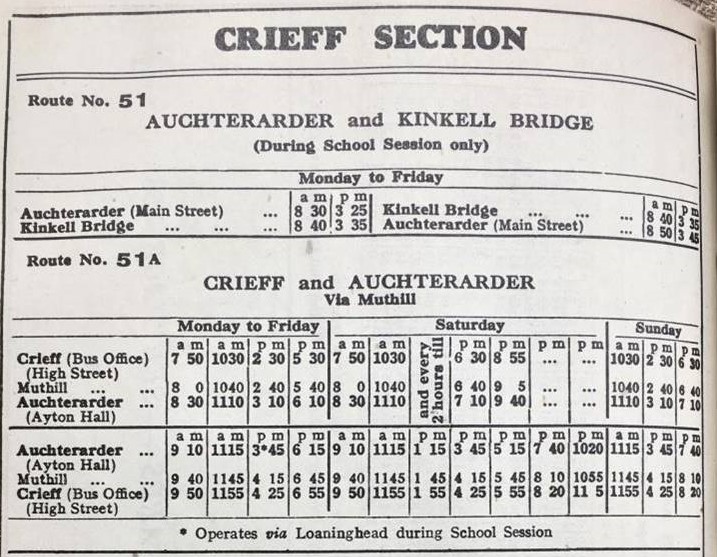
David Ferguson Collection
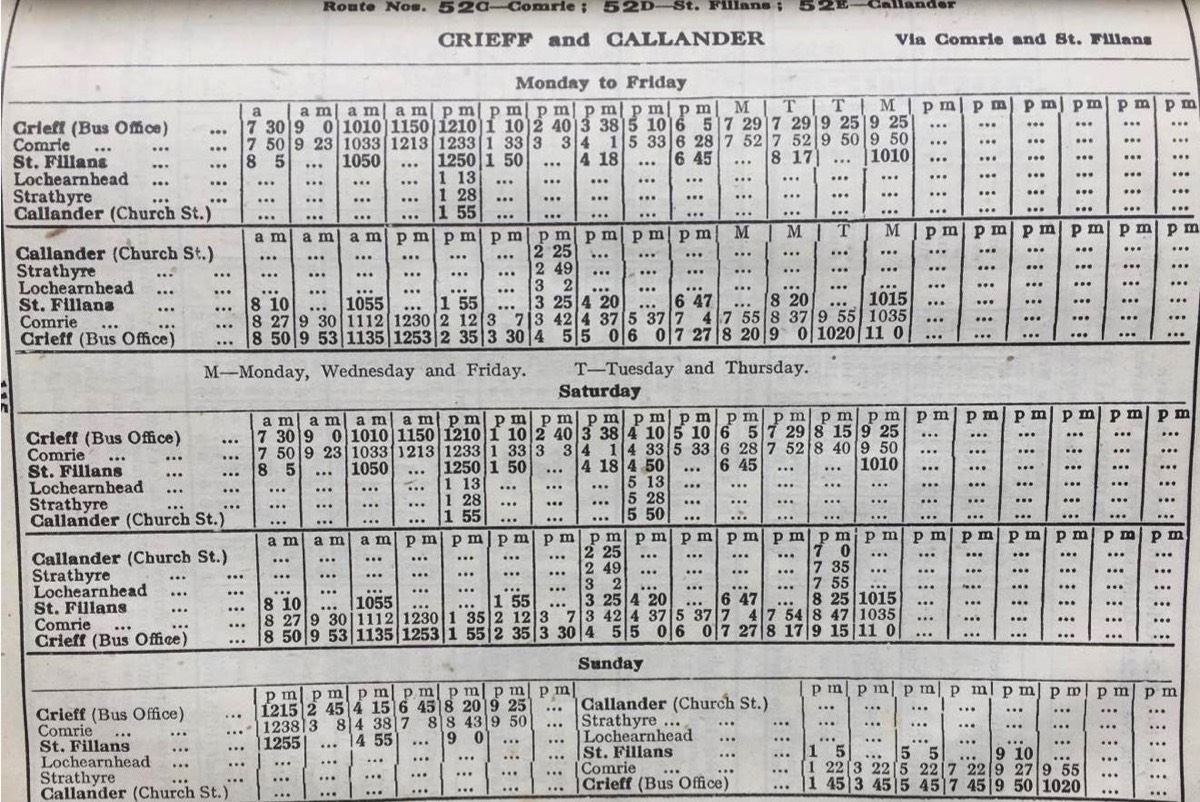
5 Alexander's Crieff-Callander 1943 Timetable David Ferguson Collection
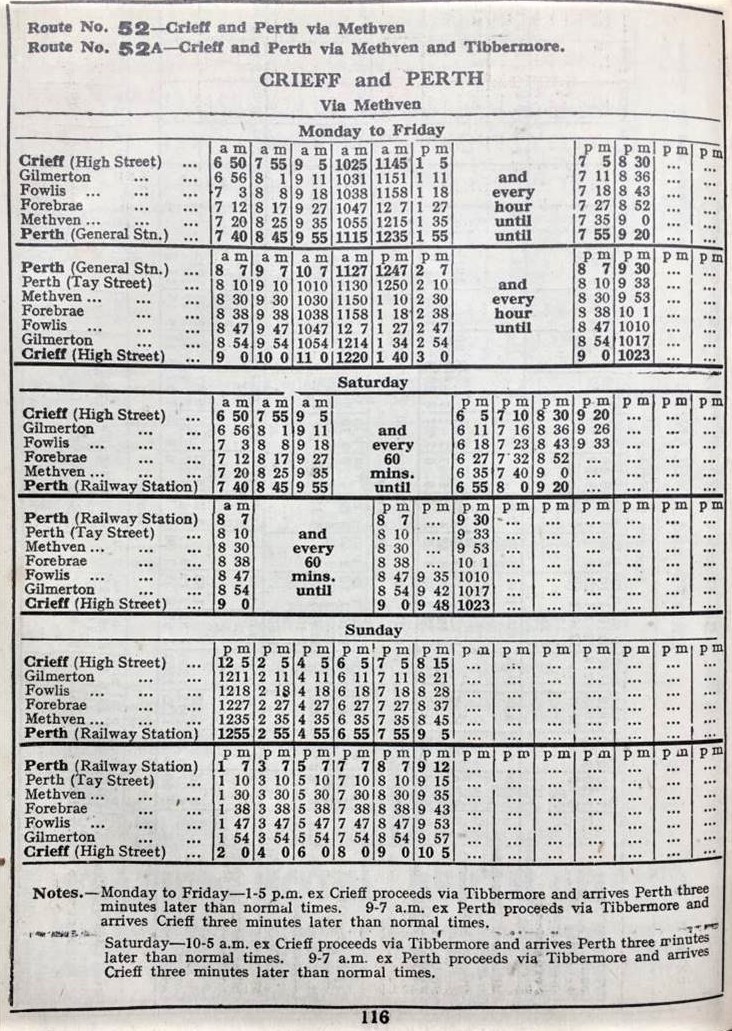
6 Alexander's Crieff-Perth 1943 Timetable David Ferguson Collection
Two weeks later troops moved into Crieff Hydro and Ferntower House, both of which had been commandeered for the war effort – with it even being announced from Germany by Lord Haw-Haw!
Abercairny House, Dunira House, Ruberslaw, and Methven Castle were soon also all commandeered and served as convalescent hospitals, while Strowan House, near Comrie was requisitioned by the Polish cavalry. Cultoquhey House served for the duration of the war as Brigade Headquarters.
Abercairny House, Dunira House, Ruberslaw, and Methven Castle were soon also all commandeered and served as convalescent hospitals, while Strowan House, near Comrie was requisitioned by the Polish cavalry. Cultoquhey House served for the duration of the war as Brigade Headquarters.
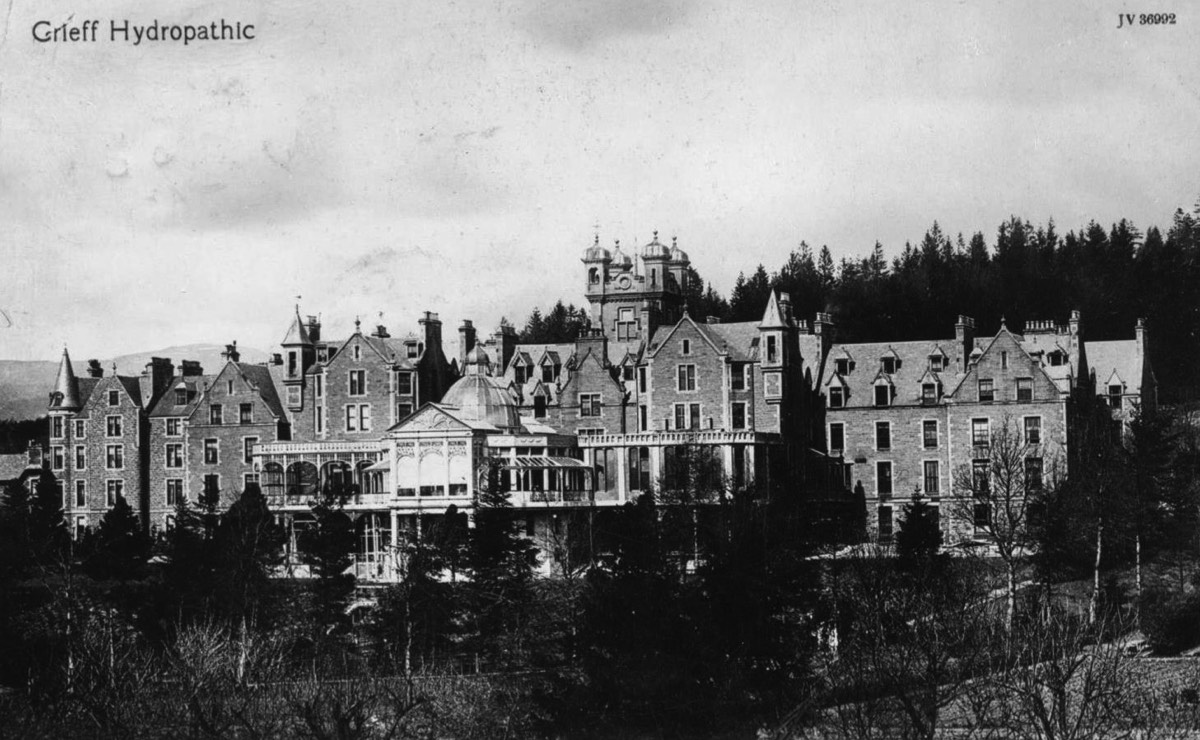
7 Strathearn House commandeered early in WW2 postcard - P&K McArthur Collection
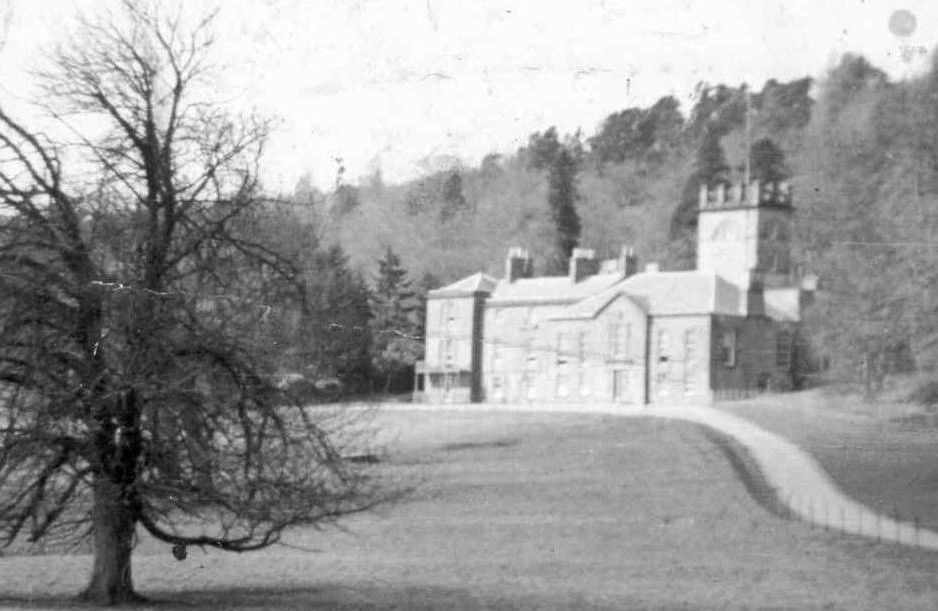
8 Ferntower House commandeered early in WW2 - David Ferguson Collection
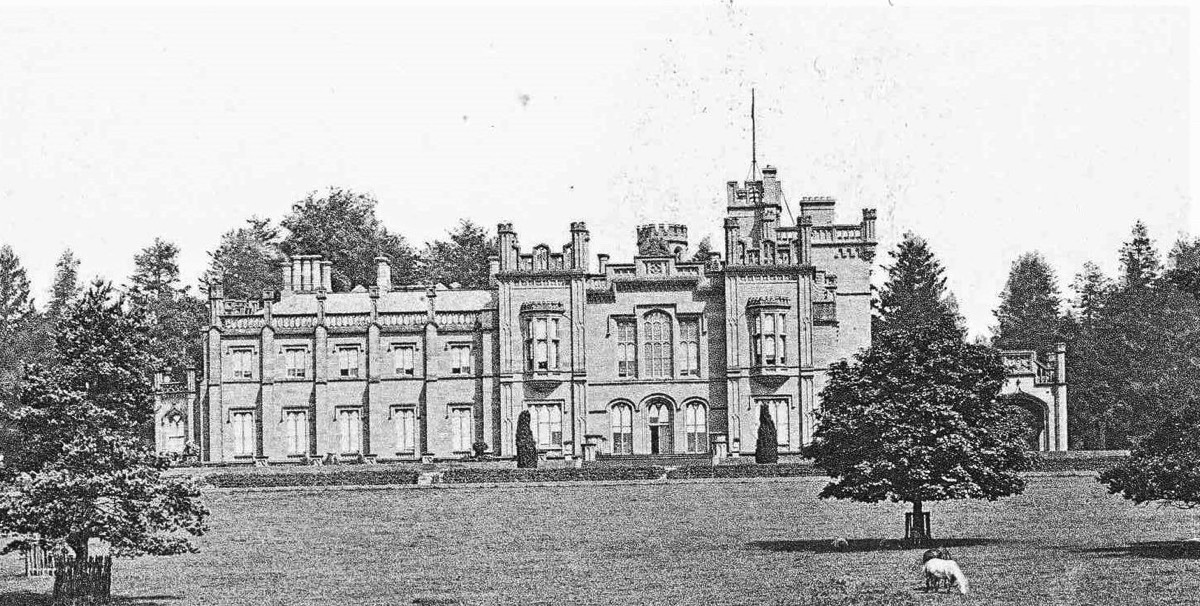
9 Abercairny House served as a convalescent hospital - CPK Collection
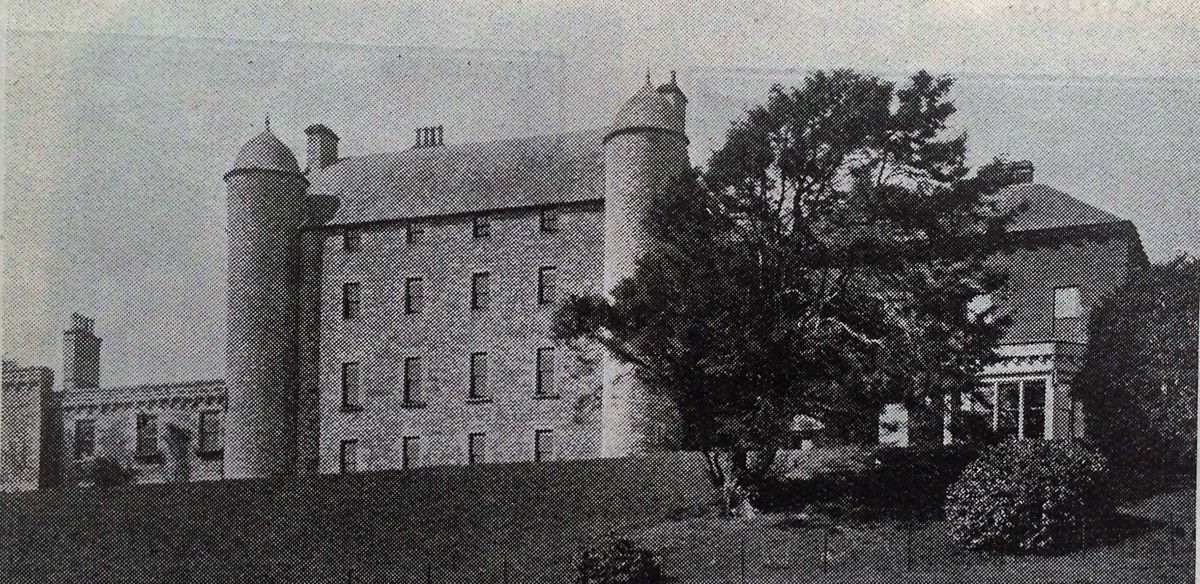
10 Methven Castle served as a convalescent hospital - Perthshire Advertiser Annual - CPK
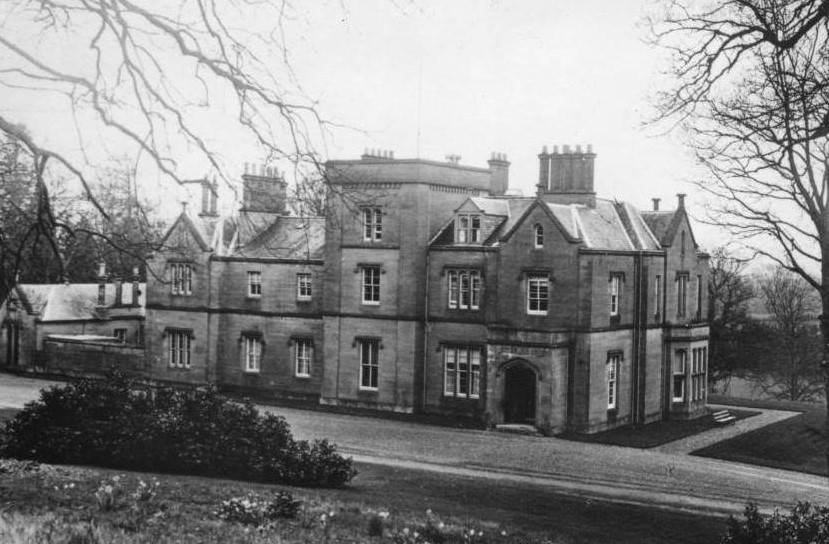
11 Cultoquhey House served as Brigade HQ - P&K Hugh McArthur Collection
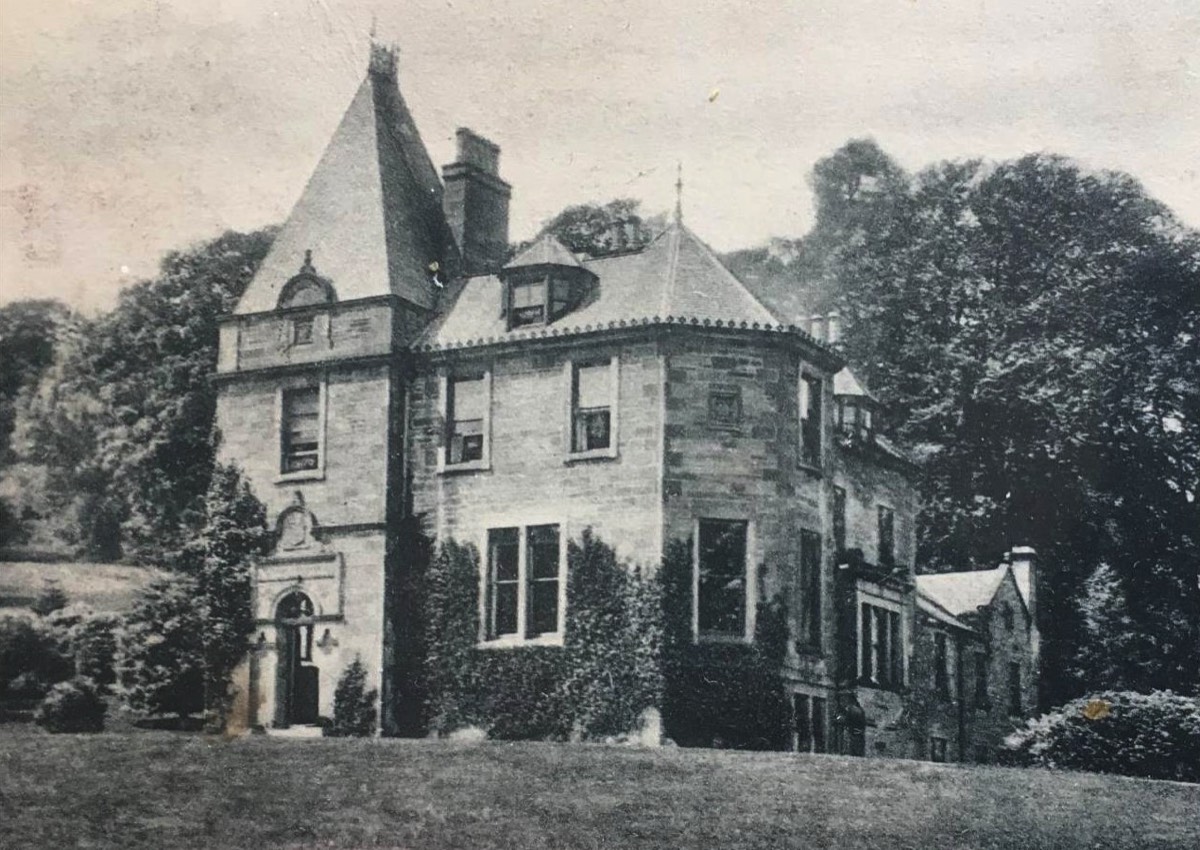
12 Strowan House was requisitioned by the Polish Cavalry - David Ferguson Collection
Other local changes noted included some Muthill locals wondering why tarmac roads had been constructed into the centre of Caerlaverock Woods, by Muthill Station, but it was soon apparent that an ammunition dump had been based there and was guarded by members of the Highland Light Infantry from Glasgow. This gave rise to the area becoming known as ‘Hellfire Corner’. Another known dump was near Balquhidder Station. It is not coincidence that both these dumps were sited by stations, so it appears from early on the local railways were moving troops and ammunition into Strathearn.
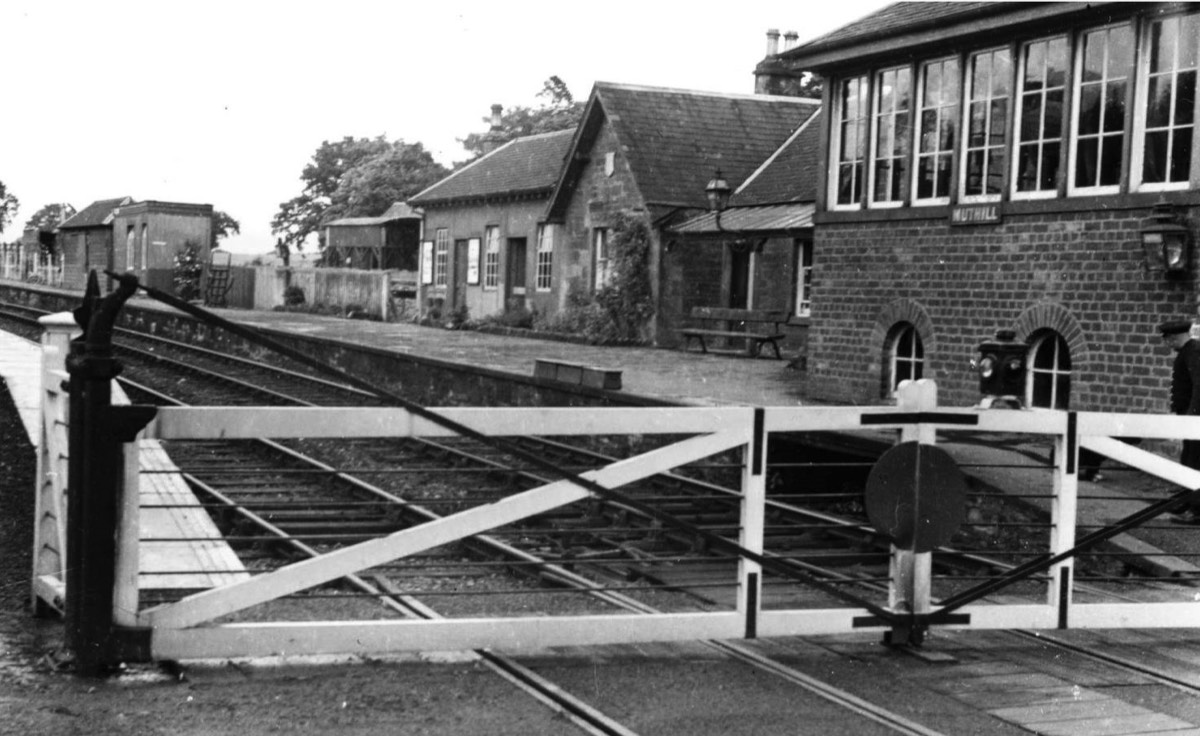
13 Muthill Station looking North with the ammunition dump sited in the trees behind - McEwen Collection
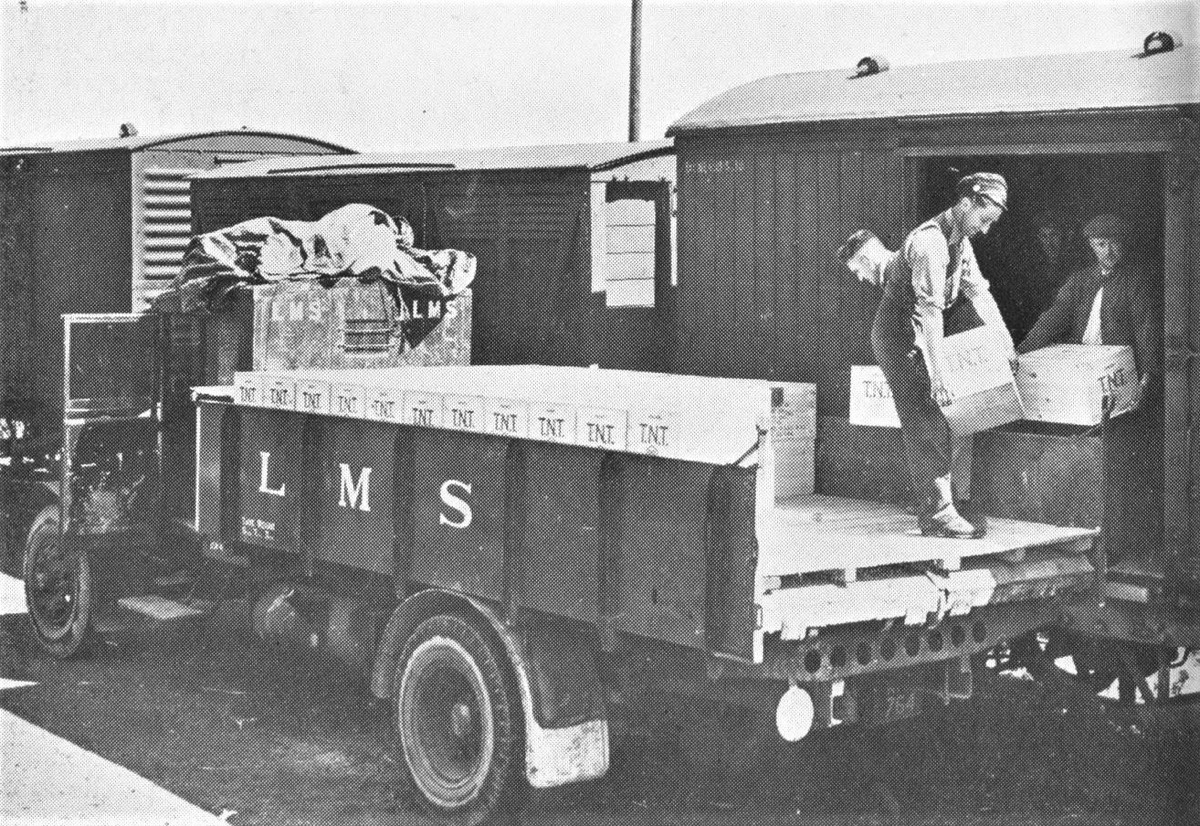
14 Moving explosives by rail to an ammunition dump - Railway Magazine
Over time many places across Strathearn were commandeered for military use, including in Crieff where the West End Garage underwent alterations to accommodate military vehicles for maintenance, huts appeared as living quarters in the Market Park, Taylors Institution became a base and the Masonic Hall (old library) and the Scout Hall both served as canteens. The troops seen locally at different times from 1939 included recruits from Stonehaven, a Battalion of the Inniskillen Fusiliers, a Battalion of the Wiltshire Regiment, a Battalion of the Cameronian’s, the 52nd Lowland Division, and two Battalions of the Highland Light Infantry. Until the end of the war, there were always troops in Crieff, including Canadians. Many towns and villages saw their populations increase over this time, although sometimes it was members of the public still trying to carry on as normal and continuing to have their holidays at places inland, rather than along the coast, as they were seen as safer resorts being away from the bombing taking place by the ports.
Obviously this rise in military traffic kept the railways busy and perhaps also shows why the regular train service had been reduced.
Gleneagles Hotel at the end of its season in 1939 had also been transformed into a hospital for war wounded and had its own special ambulance train (no.101) attached to it, which could travel to the back door of the hotel on the service siding. With the fall of Norway and France, 101 was to see a lot of action. John Young in ‘Branch Lines of Strathearn’ notes that ‘on one occasion 100 Polish wounded soldiers arrived, were detrained, and admitted in 20 minutes’. Ambulance Trains are the only trains known to have conveyed ‘passengers’ along the siding into Gleneagles Hotel. From May 1943 Gleneagles changed to become a rehabilitation centre for Miners and 1,700 were treated here by December 1945.
Obviously this rise in military traffic kept the railways busy and perhaps also shows why the regular train service had been reduced.
Gleneagles Hotel at the end of its season in 1939 had also been transformed into a hospital for war wounded and had its own special ambulance train (no.101) attached to it, which could travel to the back door of the hotel on the service siding. With the fall of Norway and France, 101 was to see a lot of action. John Young in ‘Branch Lines of Strathearn’ notes that ‘on one occasion 100 Polish wounded soldiers arrived, were detrained, and admitted in 20 minutes’. Ambulance Trains are the only trains known to have conveyed ‘passengers’ along the siding into Gleneagles Hotel. From May 1943 Gleneagles changed to become a rehabilitation centre for Miners and 1,700 were treated here by December 1945.
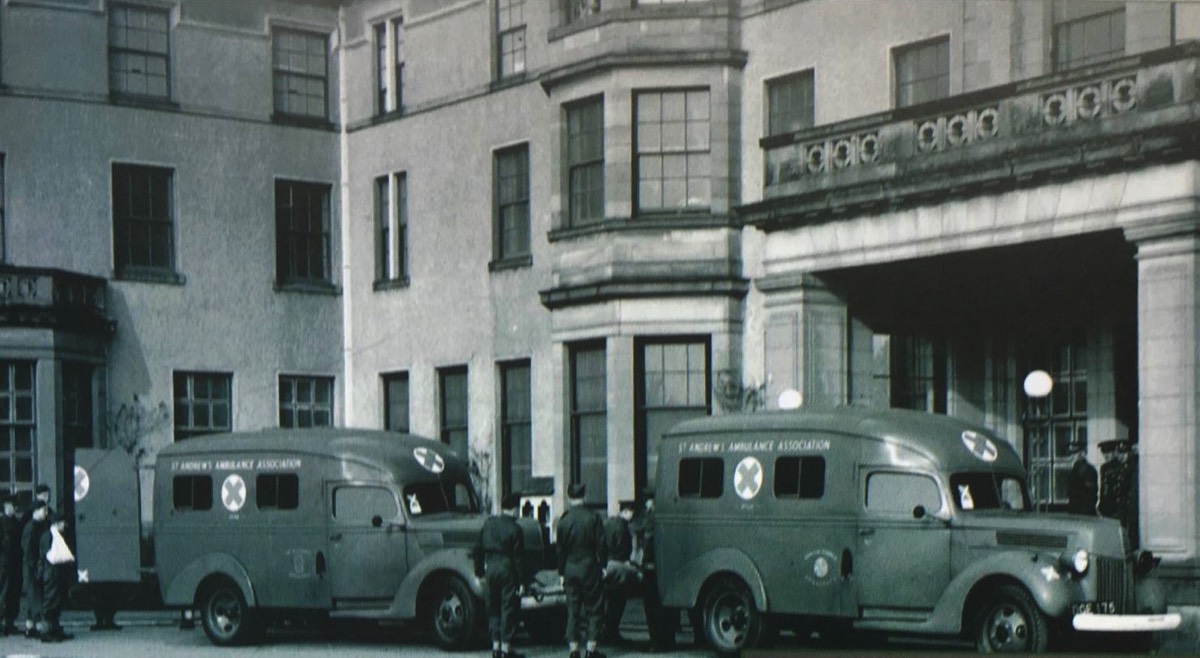
15 Gleneagles Hotel-Hospital - Glasgow University
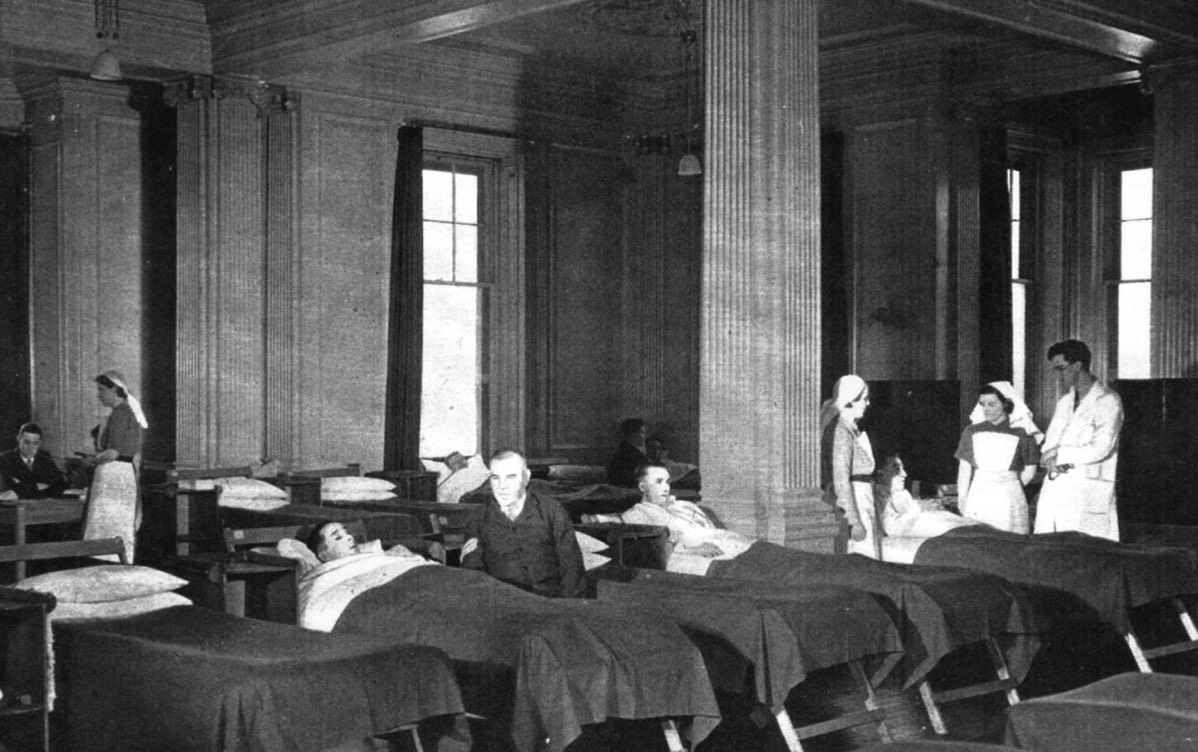
16 Ward in Gleneagles Hotel / Hospital - LAC Horne Collection - David Ferguson Collection
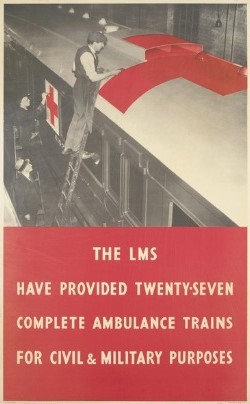
17 LMS ambulance trains publicity poster - Imperial War Museum
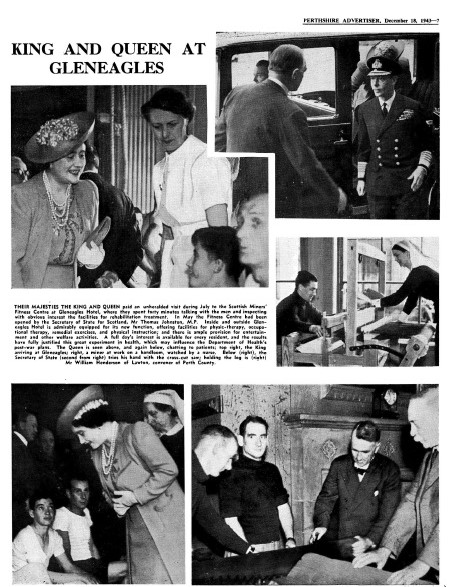
18 King and Queen at Gleneagles Miners Rehabilitation Centre in 1943 - Perthshire Advertiser Annual CPK
Other traffic generated for the railways was the huge effort by the public for recycling and collecting items from aluminium to rosehips (collected as a source of vitamin C, and 5,360lbs (2,430kg) were collected and dispatched from Comrie in 1945) and sphagnum moss used to help clean wounds (22 cases were dispatched from Ross at Comrie in August 1940). There were also countless groups the length and breadth of Strathearn knitting socks and making dressings, all of which had to be carried to collecting centres or straight to the Front and the railways played their part, as did the buses. In August 1940 the Strathearn Herald reported that ‘Crieff has lent more money per head of population to the Government than any other city, town or burgh in Scotland.’ One of the many items recycled were railings, which Crieff lost by the ton in 1944.
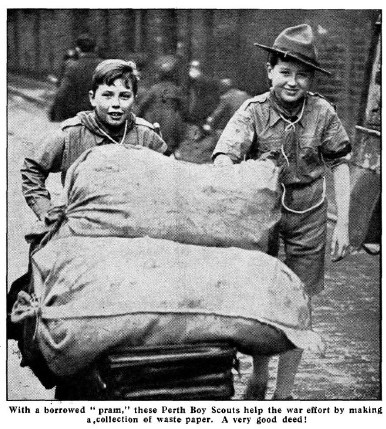
19 Perth scouts collect waste paper 1941 - Perthshire Advertiser Annual CPK
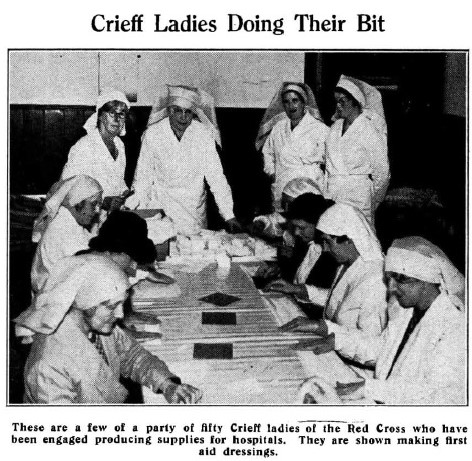
20 Crieff Red Cross ladies in 1939 making dressings - Perthshire Advertiser Annual CPK
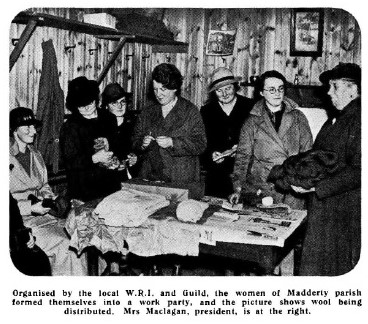
21 Madderty WRI making Forces items with wool in 1940 - Perthshire Advertiser Annual CPK
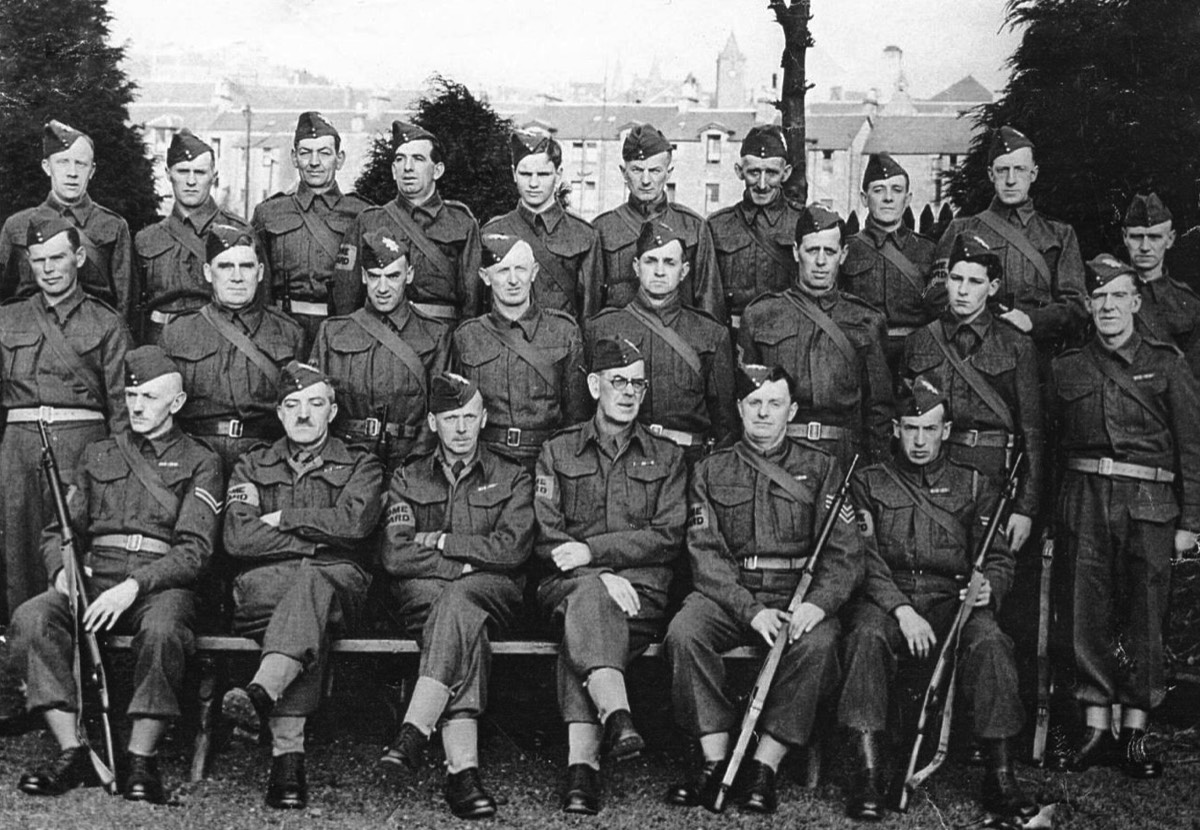
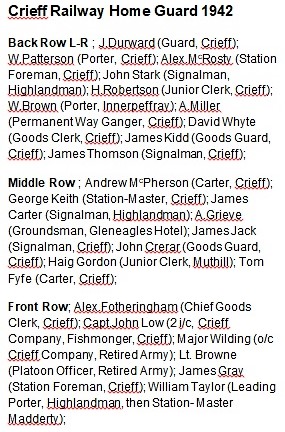
Strathearn and Crieff in particular became very busy as the war progressed. The Herald reported that ‘Due to obvious causes, traffic on Crieff streets for some time past has been extraordinary, not to say dangerous. Heavy vehicles, tons in weight, lumbering along, are said by the vibration they cause to be dislodging slates of buildings.’
As things became more serious, Home Guard units were set up, including one at Crieff Station. The aim of these units was to protect vital lines of communication and resources across the country. The unit at Crieff Station was comprised of railway personnel of different grades and from various local stations, who met up at Crieff for training and the allocation of duties. During 1941 some German bombers returning after the Clydebank Blitz apparently flew over Strathearn and jettisoned the remains of their bomb loads. One bomb fell in Glen Lednock, another in Glen Turret, and one near Muthill.
1941 was a busy year in Strathearn with many military construction projects underway, and no doubt many of the materials were brought into the area by train. The projects included the Prisoner of War camps at Cultybraggan and Crieff, plus army camps and airfields at Findo Gask and elsewhere, plus a large NAAFI (Navy, Army and Air Force Institutes) complex which was established at Balgowan, which had accommodation for 40 wagons. The NAAFI at Balgowan were responsible for feeding the PoW camps at Cultybraggan, Bankfoot and Errol, and the army bases at Findo and Trinity Gasks. An ex-Railway Clerk reckons that approximately 2 train loads of supplies were dispatched each night, while a Ministry of Transport report in 1946 stated that the depot was still considerably used and 12 wagons of flour had arrived the morning of the inspection (26th September) and around 30 loaded wagons left each week.
As things became more serious, Home Guard units were set up, including one at Crieff Station. The aim of these units was to protect vital lines of communication and resources across the country. The unit at Crieff Station was comprised of railway personnel of different grades and from various local stations, who met up at Crieff for training and the allocation of duties. During 1941 some German bombers returning after the Clydebank Blitz apparently flew over Strathearn and jettisoned the remains of their bomb loads. One bomb fell in Glen Lednock, another in Glen Turret, and one near Muthill.
1941 was a busy year in Strathearn with many military construction projects underway, and no doubt many of the materials were brought into the area by train. The projects included the Prisoner of War camps at Cultybraggan and Crieff, plus army camps and airfields at Findo Gask and elsewhere, plus a large NAAFI (Navy, Army and Air Force Institutes) complex which was established at Balgowan, which had accommodation for 40 wagons. The NAAFI at Balgowan were responsible for feeding the PoW camps at Cultybraggan, Bankfoot and Errol, and the army bases at Findo and Trinity Gasks. An ex-Railway Clerk reckons that approximately 2 train loads of supplies were dispatched each night, while a Ministry of Transport report in 1946 stated that the depot was still considerably used and 12 wagons of flour had arrived the morning of the inspection (26th September) and around 30 loaded wagons left each week.
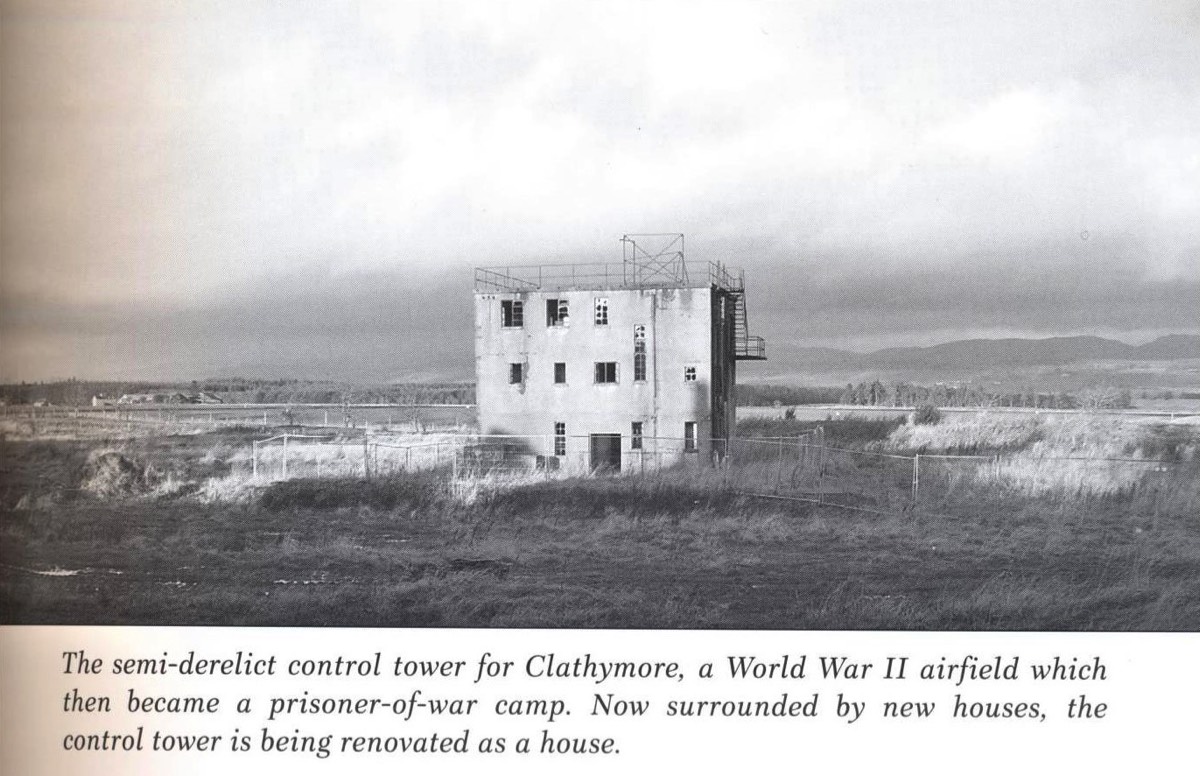
25 Findo Gask airfield control tower at Clathymore - Lost Perthshire by Ann Lindsay 2016
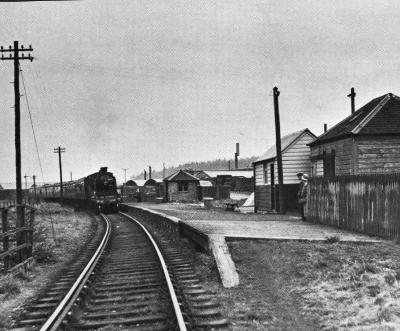
24 Remains of Balgowan in 1962 with the NAAFI camp now a sawmill seen to the right of the train - CJ Gammell
Cultybraggan was a large camp and could contain around 4,000 prisoners. It was eventually to become one of the UK’s detention centres for the worst calibre of people, with hardened members of the SS among its inmates. In November 1943 members of the Afrika Korps arrived at Comrie and residents recall the trains distinctly, as they generally originated at the Channel ports and so were made up of Southern Railway carriages painted in malachite green, while others were made up of Great Western Railway carriages in chocolate-and-cream livery, so making an interesting change from the maroon livery of the LMS Railway’s carriages that were usually seen on the line. James Hardie in ‘Comrie Character’s and Cameos’ published in 2000, remembers ‘One Sunday when no trains whatever used our line to Balquidder’s main line junction, we were all astounded to hear the unmistakable noise of a train travelling and stopping in the station. Many heard and saw as a large engine of a main line variety called a Black Five pulled eight main line passenger coaches into the station.’ Watching from a vantage point in Drummond Street, Comrie, James watched the proceedings as a body of strangers marched towards him. ‘As they grew nearer it was observed that they marched three abreast in one very long, unbroken column, with the Jocks of the camp stepping alongside, with some yards from one to the next on each side of the column, now seen to be obviously prisoners under guard... They were very erect, and of splendidly proud bearing, even although wearing only trousers and singlet, just as they had been when captured in Libyan heat... it turned out they were Rommel’s elite paratroops and were real tough guys, who glared at us with disdain as they passed only 4’ out from the kerb. .. Not all of the column were German paratroopers, for much of the rear had a good contingent of Italians, extremely miserable in this weather as they were again dressed in trousers and singlets, although they’d managed to grab musical instruments from somewhere. Altogether seven such identical trains pulled by Black Fives (and sometimes with 2 engines) disgorged prisoners that day.’
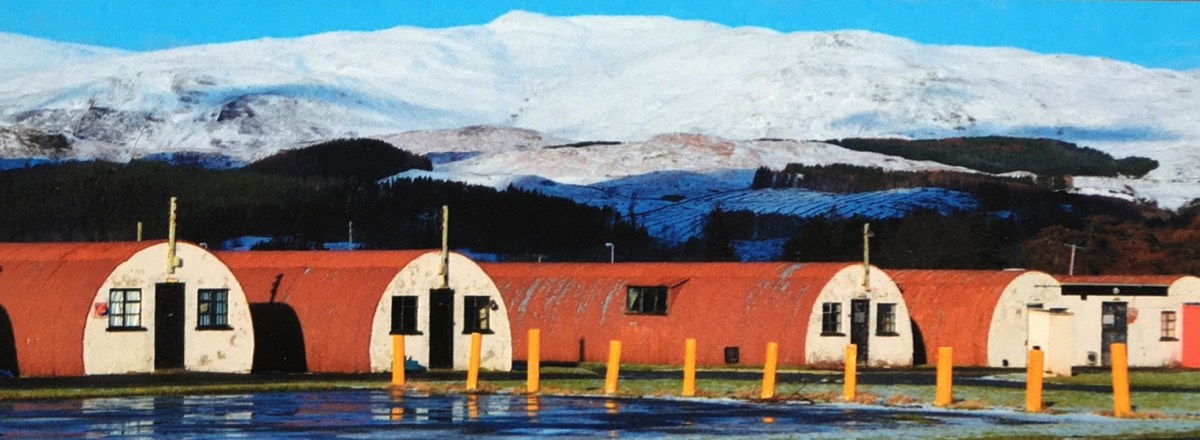
26 Cultybraggan Camp - Cultybraggan Local History Group and Comrie Development Trust
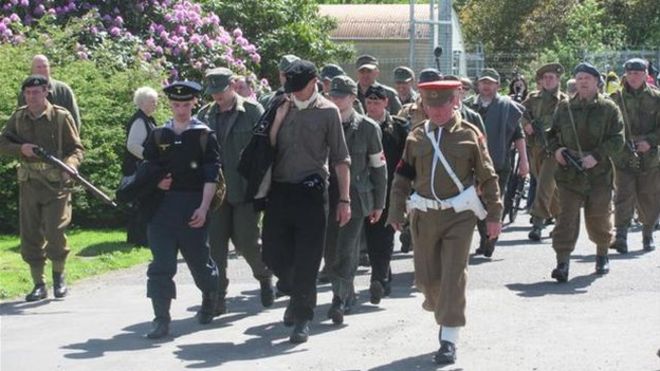
27 Re-enactment of Prisoners arriving at Cultybraggan - Cultybraggan Local History Group and Comrie Development Trust
On top of the construction traffic, there were also special trains carrying troops and vehicles into Strathearn for training. Among these were ones that James Hardie in ‘Comrie Character’s and Cameos’, recalls when ‘numbers of the latest Matilda tanks and Bren Carriers arrived. Both these machines had caterpillar tracks and all drivers seemed inexperienced as these vehicles would suddenly skid and swerve without warning, causing us to keep attentive eyes when using the roads, especially the single-track ones in the Glens! Hearing an approaching clatter, it was safer to mount the scarred and chewed verges, but it must be said, that it gave an added frisson to life!’
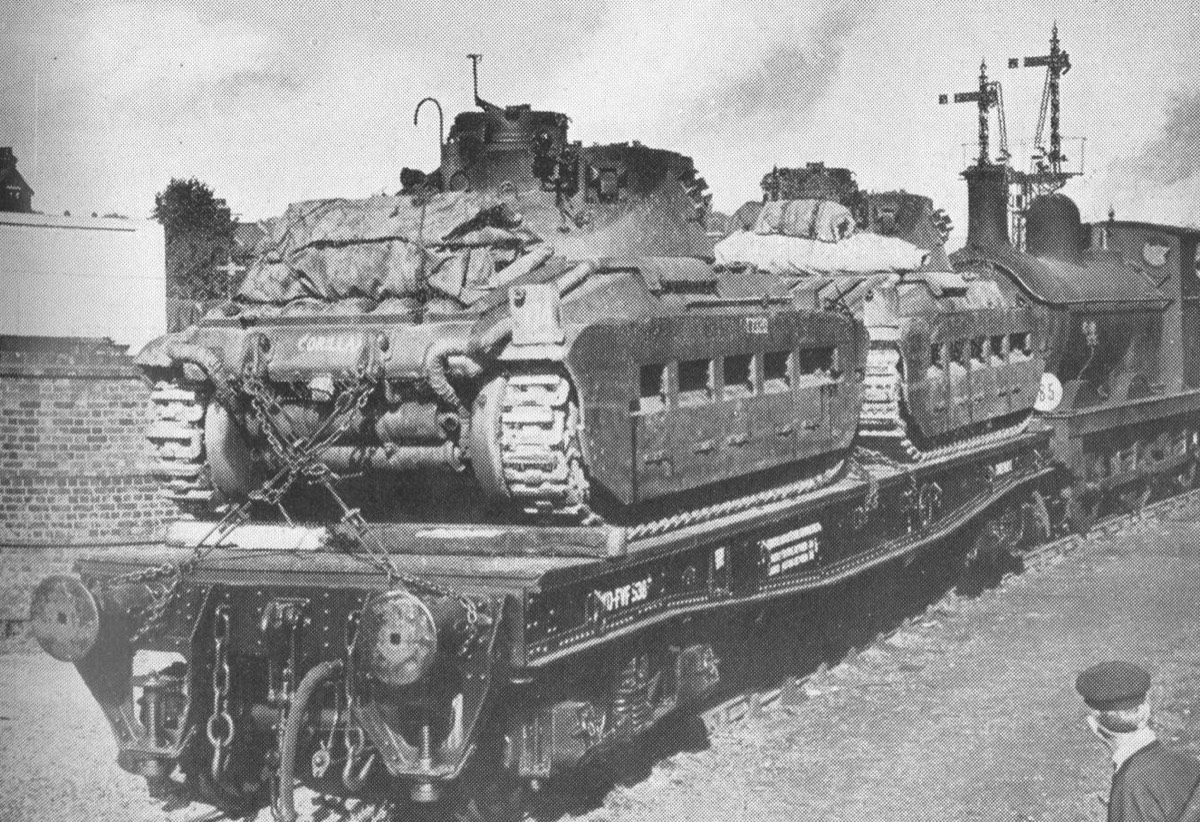
28 Tanks by rail - Railway Magazine
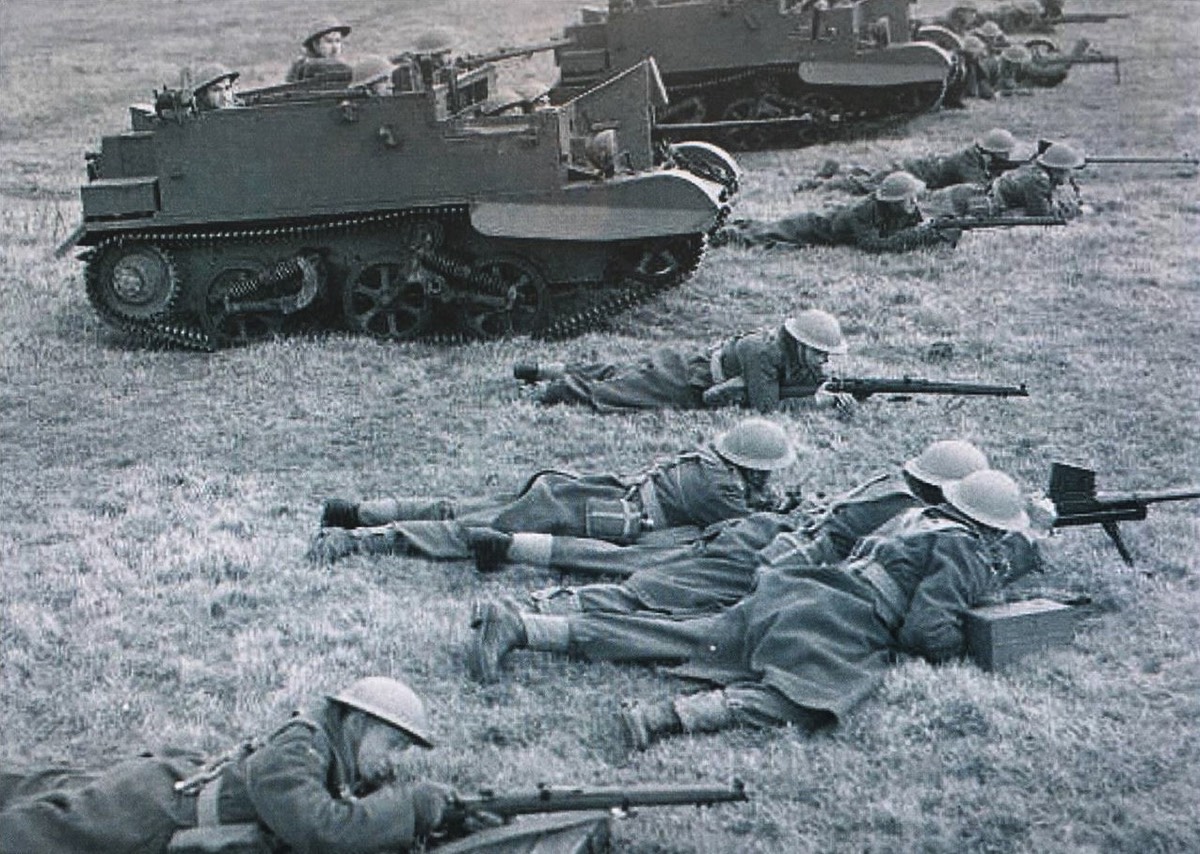
29 Troops and Bren Carriers training - Strathearn Military Post
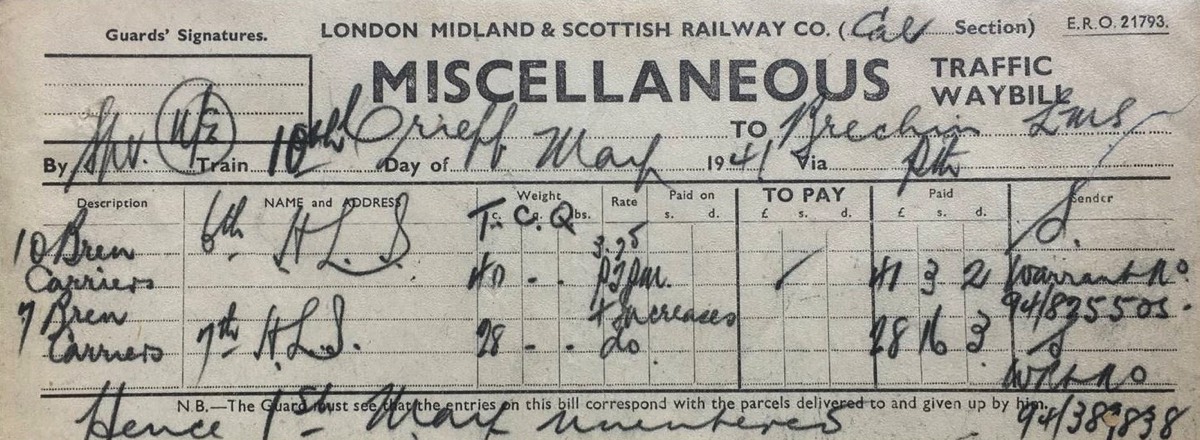
30 Carriage slip for Bren Carriers to travel from Crieff to Brechin 10 October 1941 - David Ferguson Collection
In January 1942 the Admiralty began construction of the Stores and Workshops at Almondbank for the storage and distribution of equipment in support of the Royal Navy’s Fleet Air Arm. Many different types of aircraft parts and equipment were made and stored here to maintain a variety of planes, such as Bristol Beaufighter, Fairey Swordfish, De Havilland Mosquito and Grumman Hellcat amongst others. In October 1944 the rail link into the depot was opened via a siding off the bleachwork sidings, and this helped to improve the efficiency of importing parts and supplies and to allow finished items to be returned to where they were required.
A different traffic on the railway was the carriage of flax to Blairgowrie from Strathearn where after de- seeding the crop was carded and spun into fibres. In early 1942 the Scottish Flax Co. acquired and opened the long closed Strathearn Manure Works in Crieff, at Veitch’s Siding, as a de-seeding plant, which freed up Blairgowrie from having to do the whole process. However, control of the Scottish Flax Co. was taken over by the Ministry of Supply around a year later and one of their first decisions was to close the de-seeding facility at Crieff, where 6 men and 14 women had been employed.
A different traffic on the railway was the carriage of flax to Blairgowrie from Strathearn where after de- seeding the crop was carded and spun into fibres. In early 1942 the Scottish Flax Co. acquired and opened the long closed Strathearn Manure Works in Crieff, at Veitch’s Siding, as a de-seeding plant, which freed up Blairgowrie from having to do the whole process. However, control of the Scottish Flax Co. was taken over by the Ministry of Supply around a year later and one of their first decisions was to close the de-seeding facility at Crieff, where 6 men and 14 women had been employed.
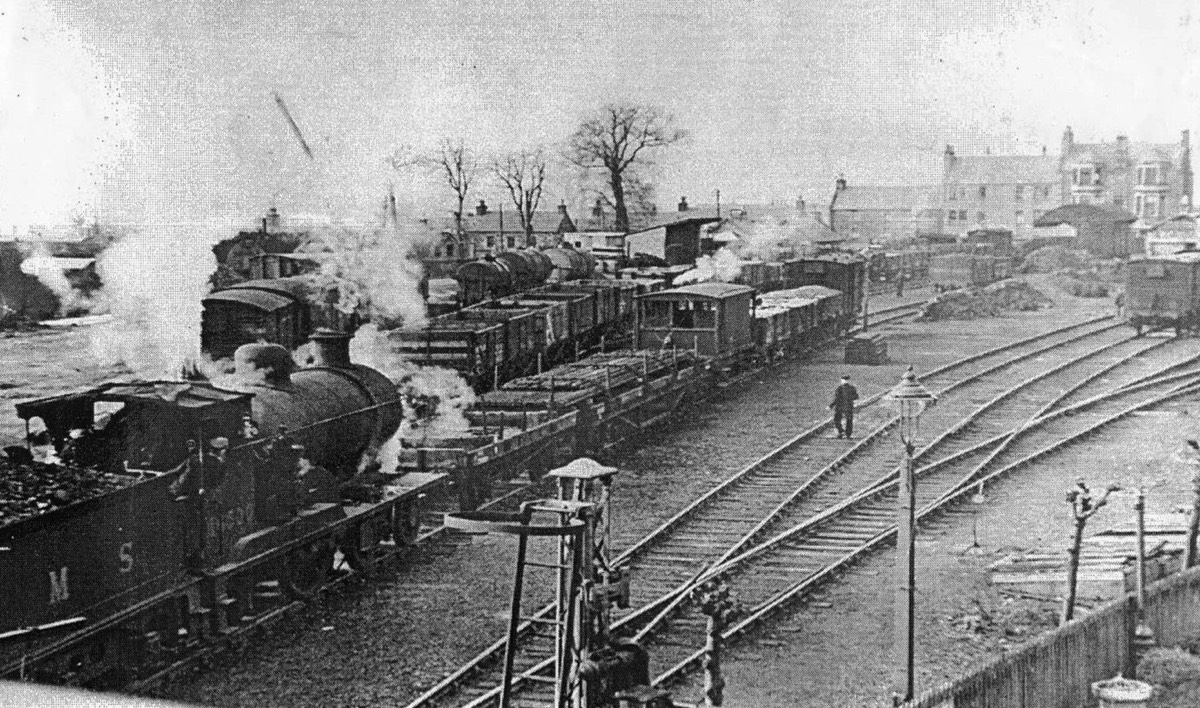
31 14500 shunts a busy Crieff Yard around the end of WW2 - Ken Hay - Caledonian Railway Association
Although members of the public were still travelling to an extent, they were having to endure harsher conditions, with fewer trains being run and therefore more crowded, fare concessions had been withdrawn, railway refreshment facilities were mostly non-existent, lighting in general had been reduced – blue bulbs were used at night-time because of the blackouts, and there was no soap or towels in the toilets. Unfortunately the reduced lighting and staffing led to an increase in damage from vandalism. Lighting restrictions began to be lifted in 1944.
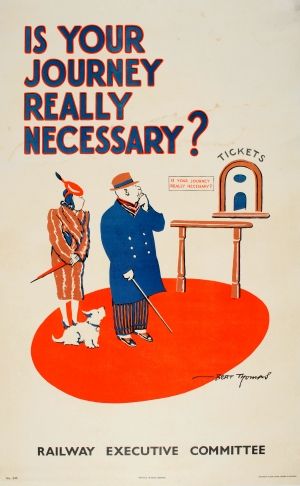
As many young men and women were called up to join the Forces, Land Girls arrived in Strathearn in December 1942 to help with the farm work, and hostels were opened for 30 girls at ‘Alcombe’, Ewanfield, Crieff, and another at Dunira, near Comrie. Women employed as foresters, or Lumberjills, were also to be seen across the area, and again most of the farm and forestry produce would have been sent on to market by rail. Female railway workers also started to be seen, including a Dundee girl called Amy, who worked at Muthill and Tullibardine as a Woman Porter, where she loaded and sheeted wagons of seed potatoes in April 1943. Helpers in 1944 also included girls from St.Gerrard’s School, Glasgow, being billeted at Ruthvenfield to help lift tatties at Tibbermore. Presumably many of these workers travelled to Strathearn by train.
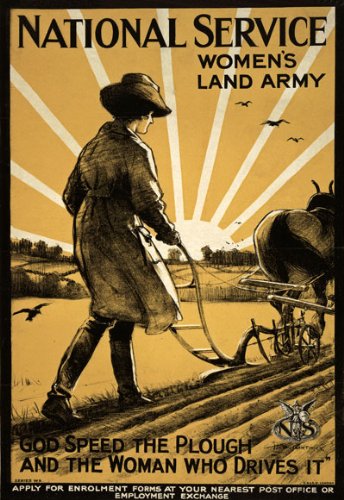
33 Women's Land Army poster - National Railway Museum
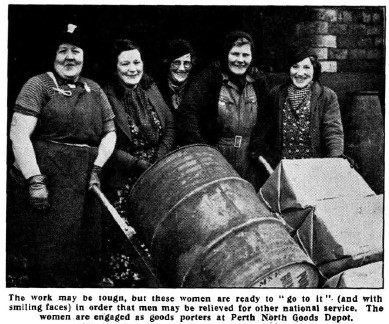
37 Female workers at Perth North Goods Shed in 1941 - PAA
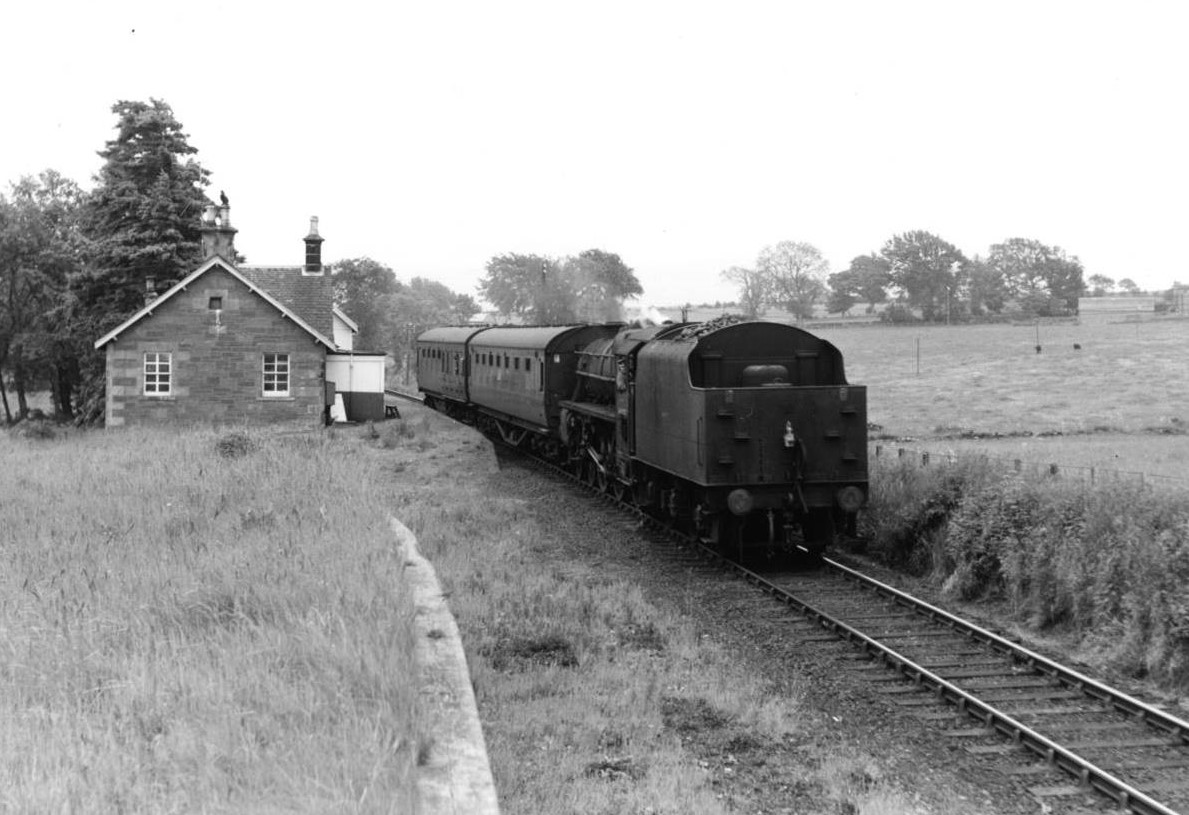
38 Tullibardine Station with the remains of the goods siding where Amy worked on the left - Douglas Hume
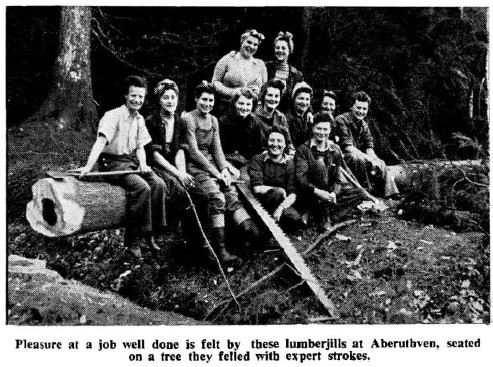
34 Lumberjills at Aberuthven in 1942 - PAA
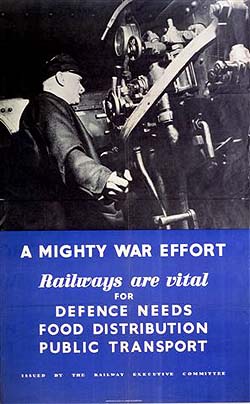
35 Railways are vital poster - National Railway Museum
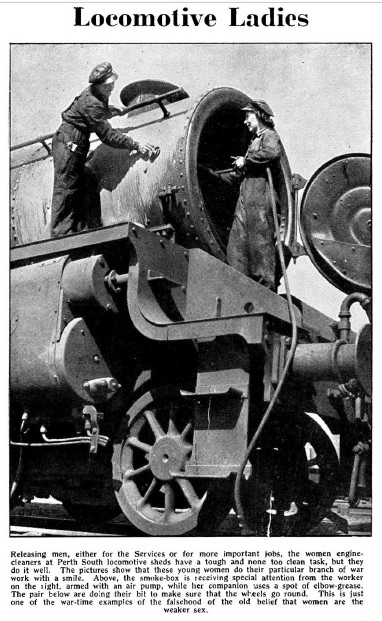
36 Female cleaners at Perth South Sheds in 1942 - PAA
Sad news struck Crieff in July 1943 with the sudden death of Station-Master George Keith. George had only taken up post in Crieff in April 1939, having served in various roles at other stations in different parts of Scotland, but he was very well liked locally. This important post at this critical time was filled 2 months later by George Rodger – apparently jocularly known as ‘Jolly’. Mr.Rodger had previously served at Abercairny and then Ballachullish, before moving to Crieff.
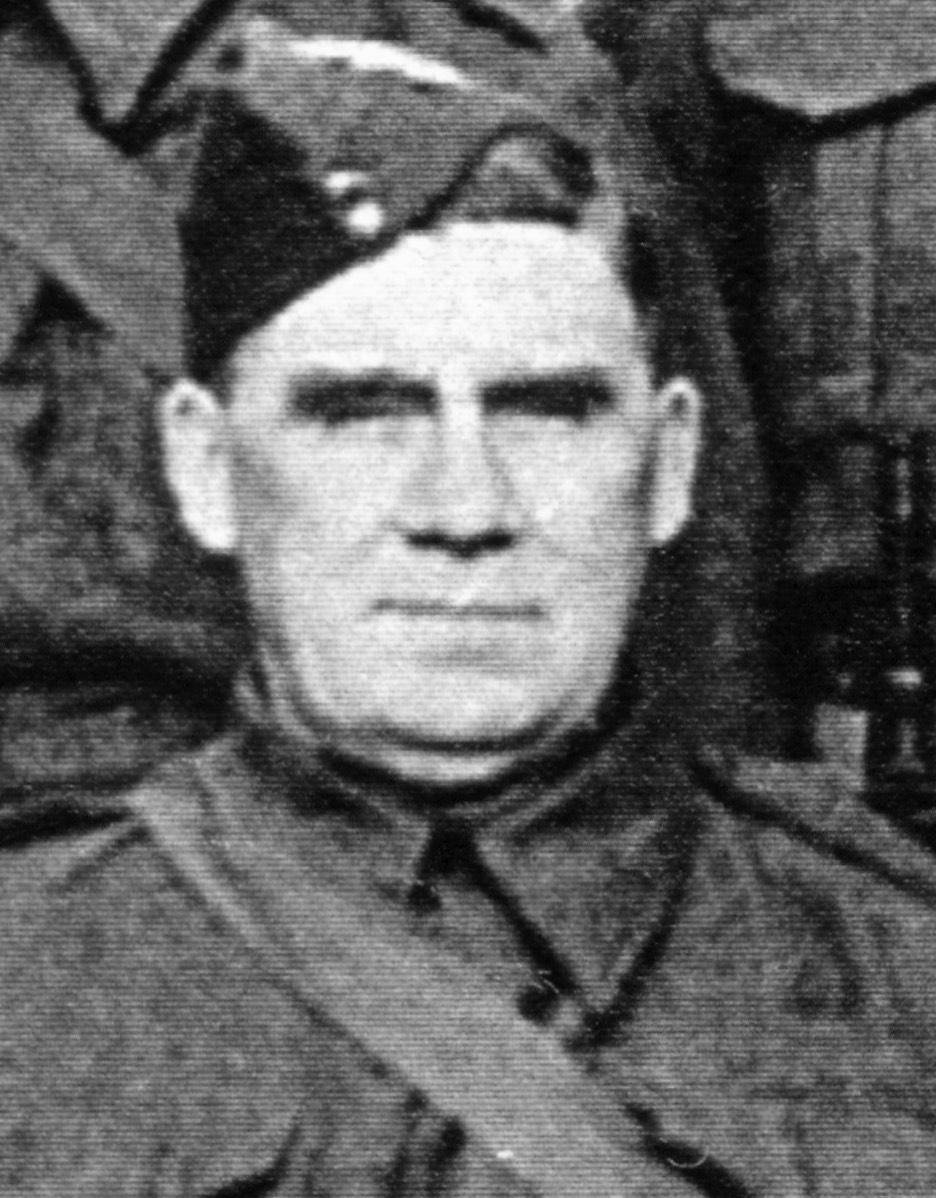
39 George Keith,, Crieff Station-Master 1939-43 - David Ferguson Collection
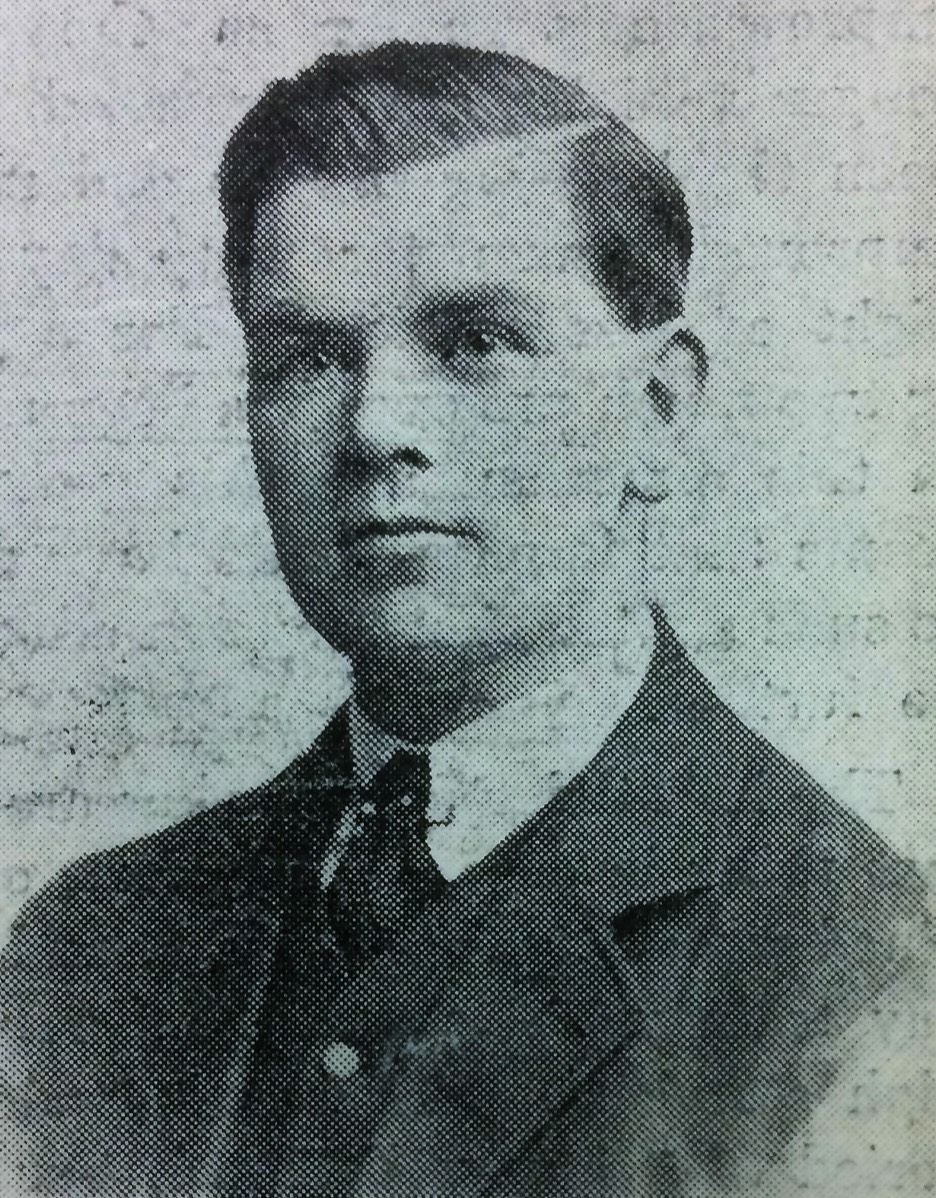
40 George Rodger, Crieff Station-Master 1943-1957 - David Ferguson Collection
Other local changes on the railway saw a new District Control Office opened in Perth and this improved the efficiency the running of the trains and speeding up of communications from all parts of the district.
For the next couple of years Strathearn’s railways continued to carry supplies and troops for training into and out of the area, trains of prisoners to the camps, servicing the local airfields and military bases, while still carrying everyday supplies for the local inhabitants, and all under the pressure of black-out regulations and increased traffic at junctions.
Although much of the traffic to pass through Perth Station during the five years of war was on the ‘Secret list’, other trains were known to include the commandos travelling north to make their famous raid on Norway; many times General Eisenhower and Field-Marshal Montgomery were seen, and Churchill also passed through on many occasions; thousands of troop trains, and military specials with guns and tanks, passed through the area, as well as ambulance trains - about 20 of which were unloaded or loaded at Perth.
For the next couple of years Strathearn’s railways continued to carry supplies and troops for training into and out of the area, trains of prisoners to the camps, servicing the local airfields and military bases, while still carrying everyday supplies for the local inhabitants, and all under the pressure of black-out regulations and increased traffic at junctions.
Although much of the traffic to pass through Perth Station during the five years of war was on the ‘Secret list’, other trains were known to include the commandos travelling north to make their famous raid on Norway; many times General Eisenhower and Field-Marshal Montgomery were seen, and Churchill also passed through on many occasions; thousands of troop trains, and military specials with guns and tanks, passed through the area, as well as ambulance trains - about 20 of which were unloaded or loaded at Perth.
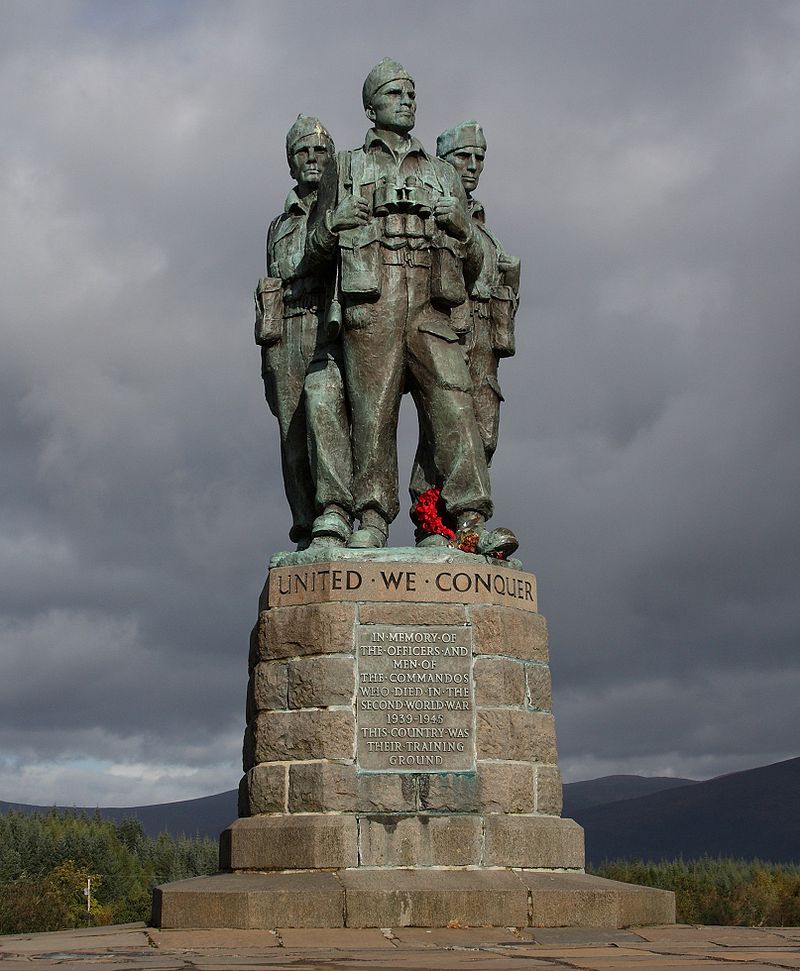
It is no doubt fair to say that Strathearn’s railways and staff certainly played their part in World war 2 in moving thousands of men and women, both military and civilian, casualties and prisoners, supplies and machinery, farm, forestry and general goods, and tons of ammunition, rosehips and lovingly crafted and much-needed personal items for the men and women on the Front. It is also likely that there was a large amount of traffic between the east and west coasts of Scotland to serve the many naval bases and other industries, such as the aluminium works at Fort William and the large amount of fish landed on west coast ports.
However, this did not prevent sad news being announced by the London, Midland and Scottish Railway on 8th August 1945 to the effect that they planned to close the line completely between Balquhidder and Crieff. Presumably, like other lines across the country, the railway had been given a pounding during the war years and would now cost a huge amount to make it fit for use for years to come. The official reason given was that it was poorly patronised, leading to a local critic to argue, ‘..a poorly timed service is provided, and then the LMS stress it’s poorly patronised and so should close the line!’ These seem to have been the same tactics employed by British Railways in 1964. Certainly traffic was declining before the war due to the rise in private car ownership and a better bus service, but this must have come like a slap on the face to the hard-working staff after their monumental efforts in very trying conditions, over the previous 5 years.
If you can add to this story with your memories or anecdotes from family and friends, I’d love to hear from you to help complete the story of the local railways during World War 2. Please contact me on 01764 654060 or via my Facebook page of Crieff Lines Railways.
However, this did not prevent sad news being announced by the London, Midland and Scottish Railway on 8th August 1945 to the effect that they planned to close the line completely between Balquhidder and Crieff. Presumably, like other lines across the country, the railway had been given a pounding during the war years and would now cost a huge amount to make it fit for use for years to come. The official reason given was that it was poorly patronised, leading to a local critic to argue, ‘..a poorly timed service is provided, and then the LMS stress it’s poorly patronised and so should close the line!’ These seem to have been the same tactics employed by British Railways in 1964. Certainly traffic was declining before the war due to the rise in private car ownership and a better bus service, but this must have come like a slap on the face to the hard-working staff after their monumental efforts in very trying conditions, over the previous 5 years.
If you can add to this story with your memories or anecdotes from family and friends, I’d love to hear from you to help complete the story of the local railways during World War 2. Please contact me on 01764 654060 or via my Facebook page of Crieff Lines Railways.
